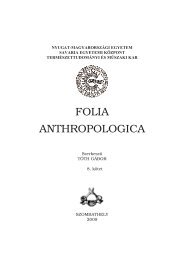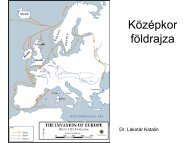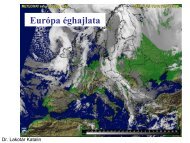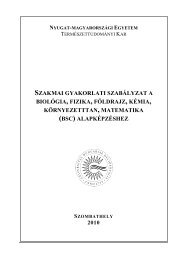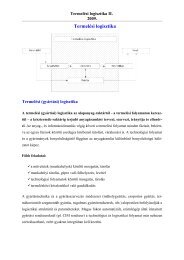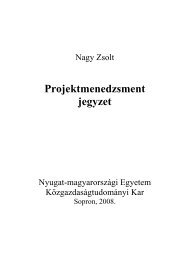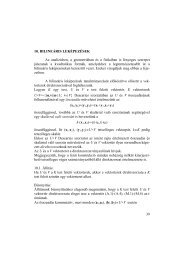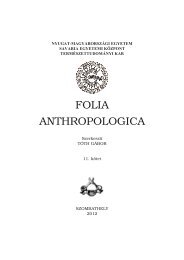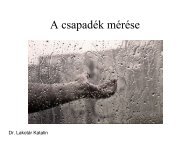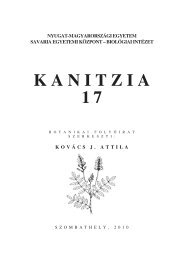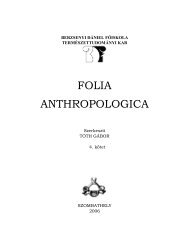Kanitzia 18. - NYME Természettudományi Kar - Nyugat ...
Kanitzia 18. - NYME Természettudományi Kar - Nyugat ...
Kanitzia 18. - NYME Természettudományi Kar - Nyugat ...
Create successful ePaper yourself
Turn your PDF publications into a flip-book with our unique Google optimized e-Paper software.
2005, CIOCÂRLAN 2009, DIHORU & NEGREAN 2009) we did not found any kind of published<br />
materials about the species presence in these localities. Extending later our docu-mentation<br />
to the website sources also (2011), we found a website indication as „The popu-lation from<br />
Frata - Onisie” (without a detailed site description and year specification), which probably<br />
refer to the same population at the Poiana Frăţii „Onisie” and, after the homepage editor<br />
and the contributors we cited as „BĂDĂRĂU et al. ined”.<br />
The plant individuals of Krascheninnikovia ceratoides were recognized after the<br />
outer morphological features: they are monoecious shrubs of 30-100 cm, with an indumentum<br />
of stellate-dendroid hairs, alternate, linear-oblong or lanceolate leaves. Unisexual flowers,<br />
male flowers in a dense spicate inflorescence, female flowers solitary or in pairs in<br />
leaf axils. The populations sampled with tomentose or lanate leaves, usualy present a grey<br />
or a reddish-brown colour after the trichomes in all vegetation time. The specimen sampled<br />
have been introduced in the Botanical collection (Herbarium) of the Hungarian Natural<br />
History Museum, [Bp].<br />
The field evaluation and characterisation of the population-stands in all four localities<br />
from the Transylvanian Basin have been realized during the vegetation time in<br />
2010. In the coenological analysis we used the standard procedures of Braun-Blanquet<br />
method. The relevés size of plots ranged between 16-25 m 2 most often 16 m 2 . The individual<br />
relevés realized in the field conditions was analysed in synoptic tables, using the constancy-class<br />
(K%) values. Cover of all vascular plant species was estimated visually. For<br />
the cover values registration in the field (A-D%) we used the more common notation in<br />
Europe, the modified Braun-Blanquet scale: + = cover < 1%, individuals 1-5; 1= cover 1-<br />
5%, individuals 6-50; 2a= cover 6-12%, various individuals; 2b= cover 13-25%, various<br />
individuals; 3= cover 26-50%, various individuals; 4= cover 51-75%, various individuals;<br />
5= cover 76-100%, various individuals (DIERSCHKE 1994, KOVÁCS 2009). Classification<br />
was performed by cluster analysis (PODANI 2001) using the index of similarity, the quadratic<br />
Euclidian distance as a distance measure and the Ward method (SPSS program). The ordination<br />
of relevés was realized after the principal component analysis using the PAST program.<br />
The nomenclature of species follows CIOCÂRLAN (2009), SIMON (2000) and OPREA<br />
(2005). The classification of the vegetation units, the plant communities description was<br />
made in accordance with the Code of phytosociological nomenclature (WEBER et al. 2000).<br />
The higher syntaxonomical units were basically assigned according to the actually literature<br />
(MUCINA 1997, BORHIDI 2003, CHYTRÝ 2007, KOVÁCS 2004, 2009, SANDA et al. 2008).<br />
Results and discussion<br />
In the large Eurosiberian distribution and disjunct area of the species stands of<br />
K. ceratoides cover variable ecological areas and make part of different vegetation types<br />
and plant communities. It is very illustrative that the sever climate condition vary from the<br />
very arid to the rather semi-humid areas: the -1,7°C mean annual temperature and 147 mm<br />
mean annual precipitation in Central Asia (in the chorological centrum), the +9,2°C mean<br />
annual temperature and 513 mm mean annual precipitation in Central Europe (Lower Austria),<br />
and + 14°C mean annual temperature and 312 mm mean annual precipitation in Northeast<br />
Spain (Heklau & Wehrden 2011 ap. Walter & Lieth 1967). The species presence in<br />
62




